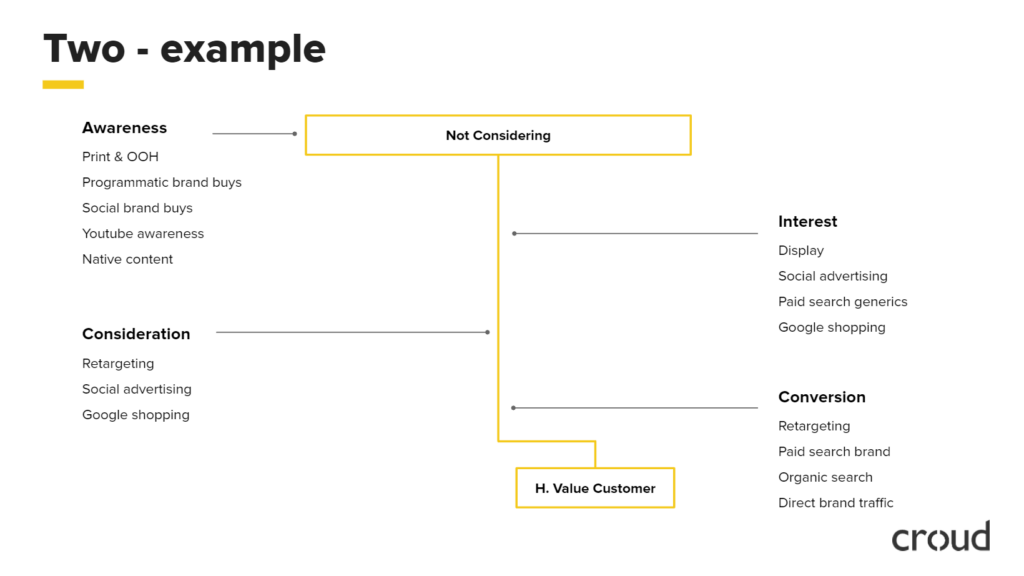That’s right. What we think we know, we don’t.
In this podcast, Kris Tait, Managing Director of Croud, explains why marketing attribution needs to start over. And, to do it successfully we REALLY need to understand our customers.
This is a slightly more advanced podcast than usual. So, for your benefit we’ve summarised Kris’ main points below and tried to explain them in an easier fashion.
Podcast above: For more from The Marketing Meetup Podcast, head to Apple Podcasts, Spotify, or just our podcast player!
Kris’ Slides can be found here so you can click along as he goes!
WHAT IS DIGITAL ATTRIBUTION?
So, your website has made a sale and you want to know where it came from. You check your active campaigns to find out the person just made the purchase by clicking through a display advert. You would then attribute the sale to a display ad, as that was the last click that brought your customer to the website and ultimately generated the sale.
This is digital attribution. It is the act of attributing one of your pre-determined goals e.g. sales, leads, newsletter sign-ups, to one of your digital touchpoints; display ads, search ads, social media posts etc.
Or at least this is one form of digital attribution, more commonly known as ‘last-click’ or ‘single-click’ attribution.
As marketers, we can use digital attribution to help us better understand our customers’ behaviour and thought processes when entering our sales funnel. Unfortunately, the method we’ve just described doesn’t give us anywhere near enough information to allow us to do that, not properly at least.
As things currently stand the ‘last-click’ attribution model is working, but that’s mostly due to the fact we have access to cookies. However, what happens in 2 years when Google removes all third-party cookies? Where do we get our information from then?
Last-click is not a sustainable attribution model.
FOCUS ON A TRUE CUSTOMER EXPERIENCE
We’ve peaked. With Google’s announcement in January 2020 and the fact that multi-touch digital attribution is so far away from being perfect, it’s time we admitted to ourselves, we’ll never reach perfect attribution.
Instead, we should now be focusing on the lifetime value of our customers. To do so, we need to understand them: their buying habits, their likes and dislikes, what matters to them. This means more investment in creating quality, first-party data. CRM systems and other customer data platforms are our greatest allies, we should start there.
ECONOMETRICS (MEDIA MIX MODELLING) AND EXPERIMENTS
As it stands digital attribution means we see an insight, spend time looking into it and ultimately go “we’ve solved it, let’s change our strategy”. The issue here though is we’ve not corroborated our data with external sources. By using a combination of Econometrics and experiments we can get a clearer picture of the true value of the customer before we go and completely change our strategy. It shows us variances in data and allows us to test it instead of running in like a bull in a china shop.
Example: You’ve had an influx of sales from a town you don’t usually campaign in. A fair prediction would be that if you start campaigning in said town, you’ll get even more sales. But, you run your campaign there and it completely flops. Why? You analyse your data, still nothing, it was an exact replica of the data you gathered from the recent influx. Further research indicates there was a town festival happening there that weekend and they required your product for the festival. You weren’t to know this based on their quantifiable data. You know this now though. So, you can attribute those sales to a new model which is based on the town’s yearly festival. Next year, you’re ready for it.
We have to bear in mind, our businesses only grow if new work comes in, for that to happen we need new customers, so experimenting is a necessity.
4 STEPS TO IMPROVE YOUR DIGITAL ATTRIBUTION
- Group your campaigns into channels according to how they operate.
Brand paid search should be separate from non-brand paid search. Prospecting and remarketing as well, they’re doing different jobs.
- Identify and map the job each channel is supposed to be doing.
A basic breakdown of channels could be awareness, interest, consideration & conversion. The awareness channel is used to create awareness of your brand. Interest is to get them interested in your product/brand. Consideration is putting the product in front of them. Conversion is aimed towards driving them to make that purchase.

- Build an attribution model for each of the channels that reward the channel for the job it’s doing.
If the goal of the channel is to raise awareness, then set KPI’s that make sense, such as CPM. It allows you to set benchmark metrics so you can ensure it’s performing as it should be.
- For each channel, compare the performance of one model vs another.
Set up dashboards to access the performance of each channel at a glance. This will enable you to compare models to see what’s working and what isn’t. From here you can tweak your models and move them around to see if they work better in other areas.
Remember, digital attribution is flawed
Before you go to Google Analytics and change your entire strategy based on your findings, check them against other data first. Otherwise, you’re changing everything based on incomplete data. Match market test to see if the results are happening over different markets.